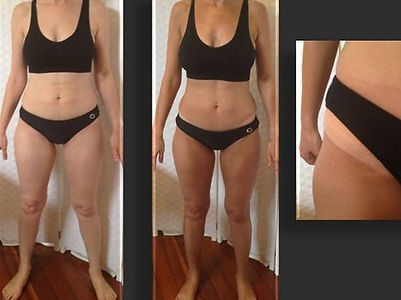
How Does My Spray Tan Work?
Our skin is made up of two main layers: the epidermis (the outer layers) and the dermis (the deeper layers).
The Epidermis
This is the barrier layer and has no direct blood supply, but instead is supported and fed by the dermis. The epidermis is our interface to the world and has two main layers, the inner layer (of which is living) and the outer layer (of which is dead). The stratum corneum (horny layer) is the collection of cells that we see as our skin; the outer layer of dead cells. The cells in this layer are filled with a protein called keratin. Keratin is a protein and our hair and fingernails gain their strength from this. It also forms the visible skin but in a much thinner and more flexible layer. This layer is the one affected by most sunless tanning products.
The Dermis
The dermis is the layer containing all the ‘equipment’ - it contains sweat glands, hair follicles nerve endings and so on.
DHA / Dihydroxyacetone
This is a colourless sugar that interacts with the dead cells located in the stratum corneum of the epidermis (mentioned earlier). It is often derived from plant sources such as sugar beets and sugar cane, and by the fermentation of glycerin.


DHA causes a chemical reaction with the amino acids in the skin, which are part of the protein containing keratin in the skin’s surface. The resulting pigments are called melanoidins. These are similar in colour to melanin (the natural substance in the deeper skin layers of the skin which go brown or ‘tan’ from exposure to UV rays). This change usually lasts about five to seven days from the initial application, until the natural dead skin cells naturally wear away from the surface of your skin. Did you know that every 35 to 45 days, you have an entirely new epidermis?
Today, DHA is the main active ingredient in all sunless tanning skincare preparations. It may be used alone or combined with other tanning components such as erythrulose. DHA is considered the most effective sun-free tanning additive.
Sunless tanning products contain DHA in concentrations ranging from 1% to 15%. Professional tanning solutions range from 5% to 15%. The percentages correspond with the product coloration levels from light to dark. The artificial tan takes 2 to 4 hours to begin appearing on the skin surface, and will continue to darken for the next 24 to 48 hours, depending on formulation type.
Exfoliation, prolonged water submersion or heavy sweating can lighten the tan, as these all contribute to rapid dead skin cell exfoliation.
6-8 Hour Tans
Traditionally, a spray tan is left on for about 6 - 8 hours. After this period, the bronzer / colour guide is washed away revealing the developed tan underneath. This will continue to develop over the next few hours.
2 Hour Tan
With a 2 hour tan you are able to wash the solution off after just 2 hours. However, this does not mean your tan would be rapidly developed. It will develop at the same speed as a 'traditional' spray tan, but you are able to wash off the bronzer / colour guide and get on with your day whilst the tan continues to develop over the next few hours. Once washed off after 2 hours, you may feel that your tan has not developed much but 3-4 hours after application you will begin to rapidly see the tan developing; it will be at its peak development at around 8-12 hours.
NOTE: That Spray Tan Place uses extractor fans, has good ventilation and stocks nasal filters, eyewear and face masks (as recommended by the FDA) should you require them.

